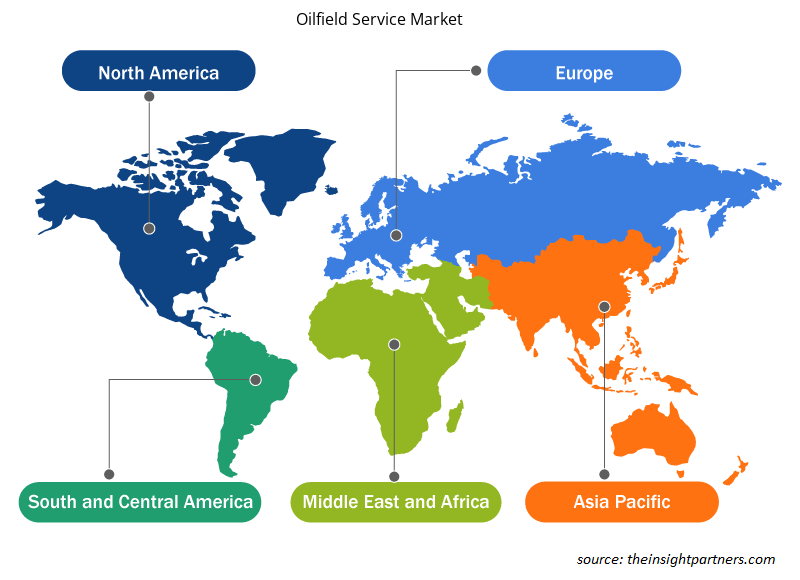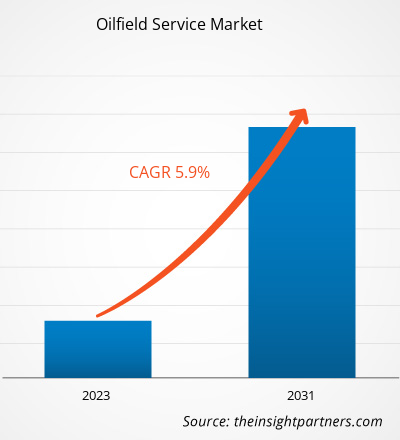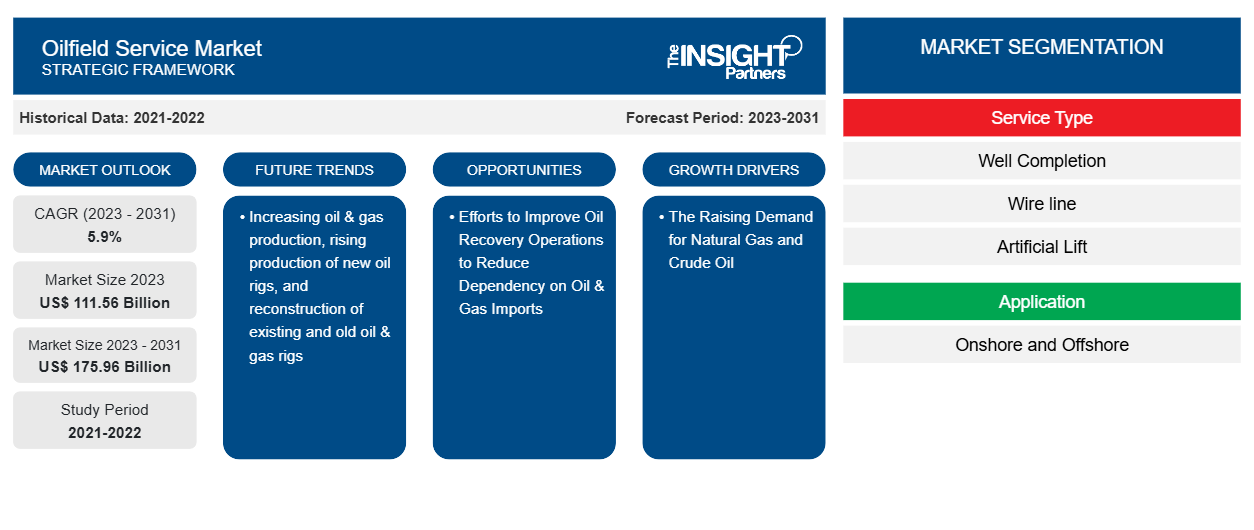Der Markt für Ölfelddienstleistungen soll von 111,56 Milliarden US-Dollar im Jahr 2023 auf 175,96 Milliarden US-Dollar im Jahr 2031 anwachsen. Der Markt wird zwischen 2023 und 2031 voraussichtlich eine durchschnittliche jährliche Wachstumsrate von 5,9 % verzeichnen. Die zunehmende Öl- und Gasproduktion, die steigende Produktion neuer Bohrinseln und der Umbau bestehender und alter Öl- und Gasbohrinseln werden voraussichtlich weiterhin die wichtigsten Trends auf dem Markt bleiben.
Ölfeld-Service-Marktanalyse
Der Markt für Ölfelddienstleistungen dürfte im analysierten Zeitraum aufgrund der steigenden Zahl von Erdgasprojekten sowie der Entdeckung neuer Ölfelder, insbesondere an abgelegenen Standorten, ein beträchtliches Wachstum erfahren. Darüber hinaus hat die Erschöpfung der bestehenden Öl- und Gasreserven in verschiedenen Ländern eine Nachfrage nach grenzüberschreitenden Pipelines für die Versorgung mit Öl- und Gasprodukten geschaffen, was das Wachstum des Marktes für Ölfelddienstleistungen ankurbelt. Die steigende Nachfrage nach kostengünstigen Transportmethoden für Öl und Gas ist einer der Hauptfaktoren, die voraussichtlich die Nachfrage nach Ölfelddienstleistungen im Öl- und Gassektor in Übersee weltweit ankurbeln werden.
Überblick über den Ölfelddienstleistungsmarkt
Mit der wachsenden Bevölkerung und Industrialisierung steigt auch der Energiebedarf auf globaler Ebene. Der Anstieg des Energieverbrauchs steigerte auch den Bedarf an Öl und Gas in Entwicklungs- und Industrieländern. Dies hat zu einer steigenden Nachfrage nach Ölfelddienstleistungen auf der ganzen Welt geführt. Darüber hinaus treiben die große Bevölkerung, das hohe Pro-Kopf-Einkommen und die schnelle Industrialisierung den Markt für Offshore-Öl- und Gasrohrverbindungen und -flansche im asiatisch-pazifischen Raum an. Die Region ist der größte Verbraucher von Rohöl und Gas. Darüber hinaus melden hochindustrialisierte Länder im asiatisch-pazifischen Raum, darunter Japan, China, Indien und Südkorea, einen steigenden Gesamtenergieverbrauch. Diese Länder konzentrieren sich zunehmend darauf, die heimische Ölproduktion durch verschiedene verbesserte Ölgewinnungstechniken anzukurbeln, was das Marktwachstum in der Region Asien-Pazifik unterstützt, um den steigenden Ölbedarf zu decken.
Passen Sie diesen Bericht Ihren Anforderungen an
Sie erhalten kostenlos individuelle Anpassungen an jedem Bericht, einschließlich Teilen dieses Berichts oder einer Analyse auf Länderebene, eines Excel-Datenpakets sowie tolle Angebote und Rabatte für Start-ups und Universitäten.
-
Holen Sie sich die wichtigsten Markttrends aus diesem Bericht.Dieses KOSTENLOSE Beispiel umfasst eine Datenanalyse von Markttrends bis hin zu Schätzungen und Prognosen.
Treiber und Chancen auf dem Ölfelddienstleistungsmarkt
Die steigende Nachfrage nach Erdgas und Rohöl begünstigt den Markt
Die Nachfrage nach Öl und Erdgas steigt weltweit stetig an. Die USA und China verzeichnen das stärkste Wachstum. Der starke Anstieg der Nachfrage nach Petrochemikalien in den USA führte zu einem erhöhten Verbrauch. Der Anstieg der Industrieproduktion sowie die hohe Nachfrage nach Transportdienstleistungen kurbeln die Nachfrage nach Petrochemikalien an und befeuern damit das Wachstum des Ölfelddienstleistungsmarktes. Darüber hinaus ist das weltweite Wachstum des Luftverkehrsaufkommens, insbesondere in den Entwicklungsländern Asiens, ein weiterer wichtiger Faktor, der zu einem erhöhten Ölverbrauch führt.
Bemühungen zur Verbesserung der Ölförderung, um die Abhängigkeit von Öl- und Gasimporten zu verringern
Die Dampfinjektion wurde in den letzten Jahrzehnten kommerziell genutzt, um die Förderung aus konventionellen Schweröllagerstätten in ihren späteren Entwicklungsstadien zu verbessern. Der eingespritzte Dampf erhöht den Gesamtdruck einer Offshore-Öllagerstätte, was dazu beiträgt, die Mobilitätsrate des Rohöls zu verbessern und ein effizientes Fließen zu ermöglichen. Infolgedessen tragen die verbesserten Ölgewinnungsmethoden dazu bei, die Förderprozesse in bestehenden Offshore-Ölquellen zu revitalisieren. Verschiedene Länder investieren in die Erneuerung ihrer bestehenden Ölressourcen, um die heimische Ölproduktion anzukurbeln und ihre Abhängigkeit von Ölimporten zu verringern. Daher wird erwartet, dass die geplante Ausweitung ihrer Öl- und Gasaktivitäten den Akteuren auf dem Markt für Ölfelddienstleistungen in den kommenden Jahren vielversprechende Wachstumschancen bietet.
Segmentierungsanalyse des Ölfelddienstleistungsmarktberichts
Wichtige Segmente, die zur Ableitung der Marktanalyse für Ölfelddienstleistungen beigetragen haben, sind Servicetyp und Anwendung.
- Basierend auf der Art der Dienstleistung ist der Markt für Ölfelddienstleistungen in Bohrlochkomplettierung, Drahtseil, künstliche Förderung, Perforation, Bohr- und Komplettierungsflüssigkeiten und Sonstiges unterteilt. Das Segment Sonstige hatte 2023 den größten Marktanteil bei Ölfelddienstleistungen.
- Nach Materialtyp ist der Markt in Onshore und Offshore segmentiert. Das Onshore-Segment hatte im Jahr 2023 den größeren Anteil am Ölfelddienstleistungsmarkt.
Ölfelddienstleistungsmarktanteilsanalyse nach geografischer Lage
Der geografische Umfang des Marktberichts für Ölfelddienstleistungen ist hauptsächlich in fünf Regionen unterteilt: Nordamerika, Asien-Pazifik, Europa, Naher Osten und Afrika sowie Süd- und Mittelamerika.
Der Ölfelddienstleistungsmarkt in Nordamerika ist in die USA, Kanada und Mexiko unterteilt. Die Region dominiert den globalen Ölfelddienstleistungsmarkt aufgrund umfangreicher Öl- und Gasexplorations- und -produktionsprojekte und eines Anstiegs neuer Aktivitäten in den USA, dem Golf von Mexiko und Kanada. In diesem Jahr gab es in den USA 912.962 Öl- und Gasquellen. Eine Zunahme der Anzahl horizontaler Bohrungen in den USA und eine Steigerung der Öl- und Schiefergasproduktion pro Bohrinsel tragen zum Wachstum des Ölfelddienstleistungsmarkts im Land bei. Die Entstehung fortschrittlicher intelligenter Ölfelddienstleistungssysteme, wie beispielsweise hochentwickelte selbstadaptive Zuflusskontroll- und -komplettierungssysteme, wird das Marktwachstum in Nordamerika in den kommenden Jahren vorantreiben. Eine hohe Nachfrage nach Onshore-Ausrüstung aufgrund bedeutender Aussichten im Permian Basin und in North Dakota, insbesondere bei einer zunehmend großen Zahl unkonventioneller Projekte, wird das Wachstum des Ölfelddienstleistungsmarkts für das Onshore-Segment vorantreiben.
Regionale Einblicke in den Ölfelddienstleistungsmarkt
Die regionalen Trends und Faktoren, die den Ölfelddienstleistungsmarkt im Prognosezeitraum beeinflussen, wurden von den Analysten von Insight Partners ausführlich erläutert. In diesem Abschnitt werden auch die Marktsegmente und die Geografie des Ölfelddienstleistungsmarkts in Nordamerika, Europa, im asiatisch-pazifischen Raum, im Nahen Osten und Afrika sowie in Süd- und Mittelamerika erörtert.

- Erhalten Sie regionale Daten zum Ölfelddienstleistungsmarkt
Umfang des Marktberichts zum Ölfeldservice
| Berichtsattribut | Details |
|---|---|
| Marktgröße im Jahr 2023 | 111,56 Milliarden US-Dollar |
| Marktgröße bis 2031 | 175,96 Milliarden US-Dollar |
| Globale CAGR (2023 - 2031) | 5,9 % |
| Historische Daten | 2021-2022 |
| Prognosezeitraum | 2023–2031 |
| Abgedeckte Segmente |
Nach Servicetyp
|
| Abgedeckte Regionen und Länder |
Nordamerika
|
| Marktführer und wichtige Unternehmensprofile |
|
Marktteilnehmerdichte: Der Einfluss auf die Geschäftsdynamik
Der Markt für Ölfelddienstleistungen wächst rasant, angetrieben durch die steigende Nachfrage der Endnutzer aufgrund von Faktoren wie sich entwickelnden Verbraucherpräferenzen, technologischen Fortschritten und einem größeren Bewusstsein für die Vorteile des Produkts. Mit steigender Nachfrage erweitern Unternehmen ihr Angebot, entwickeln Innovationen, um die Bedürfnisse der Verbraucher zu erfüllen, und nutzen neue Trends, was das Marktwachstum weiter ankurbelt.
Die Marktteilnehmerdichte bezieht sich auf die Verteilung von Firmen oder Unternehmen, die in einem bestimmten Markt oder einer bestimmten Branche tätig sind. Sie gibt an, wie viele Wettbewerber (Marktteilnehmer) in einem bestimmten Marktraum im Verhältnis zu seiner Größe oder seinem gesamten Marktwert präsent sind.
Die wichtigsten auf dem Ölfelddienstleistungsmarkt tätigen Unternehmen sind:
- Schlumberger Limited
- Weatherford International Plc
- Baker Hughes Unternehmen
- Halliburton Company
- National Oilwell Varco, Inc.
- TechnipFMC
Haftungsausschluss : Die oben aufgeführten Unternehmen sind nicht in einer bestimmten Reihenfolge aufgeführt.

- Überblick über die wichtigsten Akteure auf dem Ölfelddienstleistungsmarkt
Neuigkeiten und aktuelle Entwicklungen auf dem Ölfeld-Servicemarkt
Der Markt für Ölfelddienstleistungen wird durch die Erhebung qualitativer und quantitativer Daten nach Primär- und Sekundärforschung bewertet, die wichtige Unternehmensveröffentlichungen, Verbandsdaten und Datenbanken umfasst. Nachfolgend sind einige der Entwicklungen auf dem Markt für Ölfelddienstleistungen aufgeführt:
- Baker Hughes gab die Ausweitung des Ölfelddienstleistungs- und -ausrüstungsgeschäfts in Guyana bekannt. Baker Hughes ist bereit, in Guyana eine neue Supercenter-Anlage für Ölfelddienstleistungen und -ausrüstung zu errichten. (Quelle: Baker Hughes, Pressemitteilung, Februar 2022)
- Schlumberger Limited hat die Einführung des mehrschichtigen Kartierungsservices Periscope Edge für Bohrarbeiten angekündigt. Der Service bietet neue Messungen und einen branchenführenden Inversionsprozess in Kombination mit Cloud-Lösungen, um eine präzise Geo-Steuerung in Reservoirs während der Bohrung zu ermöglichen. (Quelle: Schlumberger Limited, Pressemitteilung, August 2021)
Marktbericht zum Ölfeldservice – Umfang und Ergebnisse
Der Bericht „Marktgröße und Prognose für Ölfelddienstleistungen (2021–2031)“ bietet eine detaillierte Analyse des Marktes, die die folgenden Bereiche abdeckt:
- Ölfeld-Service-Marktgröße und Prognose auf globaler, regionaler und Länderebene für alle wichtigen Marktsegmente, die im Rahmen des Berichts abgedeckt sind
- Markttrends und Marktdynamiken im Bereich Ölfelddienstleistungen wie Treiber, Beschränkungen und wichtige Chancen
- Detaillierte PEST- und SWOT-Analyse
- Analyse des Ölfelddienstleistungsmarktes mit Blick auf wichtige Markttrends, globale und regionale Rahmenbedingungen, wichtige Akteure, Vorschriften und aktuelle Marktentwicklungen
- Branchenlandschaft und Wettbewerbsanalyse, einschließlich Marktkonzentration, Heatmap-Analyse, prominenten Akteuren und aktuellen Entwicklungen für den Ölfelddienstleistungsmarkt
- Detaillierte Firmenprofile
- Historische Analyse (2 Jahre), Basisjahr, Prognose (7 Jahre) mit CAGR
- PEST- und SWOT-Analyse
- Marktgröße Wert/Volumen – Global, Regional, Land
- Branchen- und Wettbewerbslandschaft
- Excel-Datensatz
Aktuelle Berichte
Erfahrungsberichte
Grund zum Kauf
- Fundierte Entscheidungsfindung
- Marktdynamik verstehen
- Wettbewerbsanalyse
- Kundeneinblicke
- Marktprognosen
- Risikominimierung
- Strategische Planung
- Investitionsbegründung
- Identifizierung neuer Märkte
- Verbesserung von Marketingstrategien
- Steigerung der Betriebseffizienz
- Anpassung an regulatorische Trends























 Kostenlose Probe anfordern für - Ölfeld-Servicemarkt
Kostenlose Probe anfordern für - Ölfeld-Servicemarkt